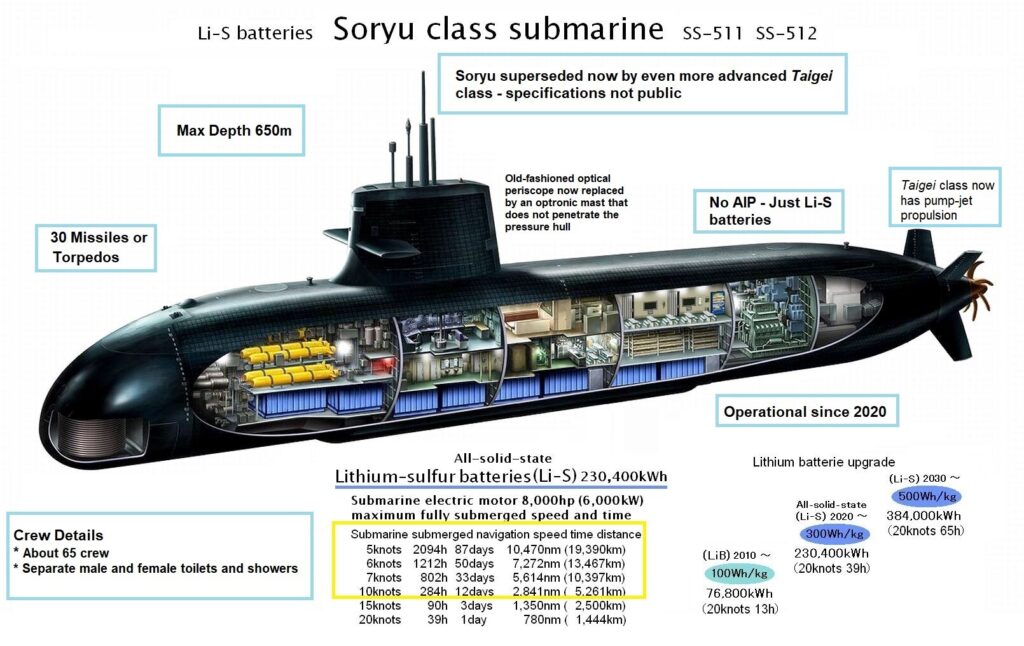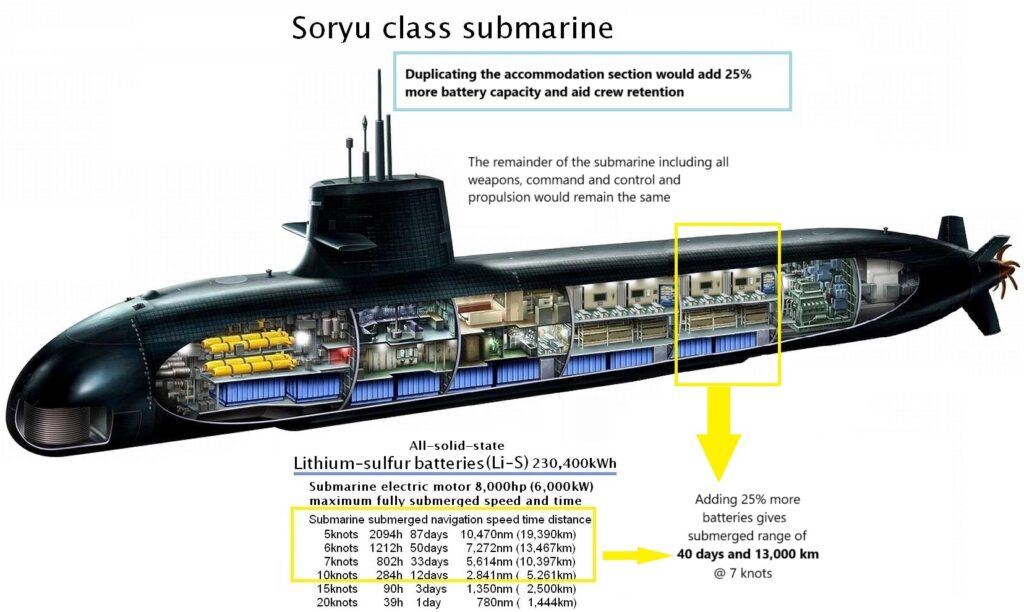A wide range of advanced non-nuclear submarines can provide excellent asymmetric defence within 4,000 km of Australia if distributed to ports around the country.
About SIX non-nuclear boats can be bought for the price of ONE Virginia class submarine. Non-nuclear boats are much cheaper to operate.
Available Non-Nuclear Submarines
| Non-nuclear boats | Manufacturer | Built | Submerged endurance |
|---|---|---|---|
| Scorpène | Naval Group / Navantia | 11 | 3 weeks if FC2G fuel cells used (diesel & O2). |
| Scorpène Evolved | Naval Group / Navantia | 0 | 12+ days with lithium-ion batteries. |
| Blacksword Barracuda | Naval Group / Navantia | 0 | Several days at top speed…probably 3+ weeks at low speed. Li batteries. |
| Type 212CD | TKMS | 0 | 3 weeks with PEM fuel cells. (2 being built) |
| Type218SG | TKMS | 3 | 4-6 weeks with fuel cell & Li batteries |
| Blekinge A26 | Saab | 0 | 3 weeks with Stirling AIP. |
| Sōryū / Taigei | Mitsubishi / Kawasaki | 7 | 4 weeks with Li-S batteries. |
| KS-III | Hanwha / Hyundai | 3 | 3+ weeks with Li-S batteries. VLS option. |
| S-80 | Navantia | 1 | 3+ weeks with bioethanol-powered fuel cells |
Current plan vs. new plan: Cost
| Current Plan | $B | Submerged endurance | New Plan | $B | Submerged endurance |
|---|---|---|---|---|---|
| 6 x Collins LOTE (full of rust) | 5 | 1 day with lead acid batteries | 20 x Advanced non-nuclear submarines (for defence) | 20 | ~30 days with fuel cells and/or lithium batteries |
| 3 x Virginia Block IV SSN (not available) | 15 | 80 days* | |||
| 5 x AUKUS SSN | 350 | 80 days* | – | 0 |
(* Nuclear subs can operate till the food runs out)
Current plan vs. new plan: Weapons
| Current | Weapons | Total | NEW | Weapons | Total |
|---|---|---|---|---|---|
| 6 x Collins LOTE | 22 | 132 | 20 x Advanced non-nuclear submarines | 30 (Taigei) | 600 |
| 3 x Virginia Block IV SSN | 37 (Includes 12 in VLS) | 111 | |||
| TOTAL | 243 | 600 |
- One class to maintain instead of three (Collins, Virginia, AUKUS)
- More weapons at sea in more places for less cost
Japanese Sōryū & Taigei submarines
“Japan’s new Taigei class … provide the Japan Maritime Self-Defense Force with some of the most advanced underwater performance of any submarine force in the world.” (US Naval Institute)
Seven Japanese submarines have been built with Lithium-Sulphur batteries to date with each one taking 2.5 years to complete. Lithium-Sulphur batteries appear to be less complex to operate and support than fuel-cell systems.
Theoretically multiple boats could be assembled in parallel in various electorates around Australia using imported components. (This would be instead of the 11 Mogami-class frigates Australia is buying from Japan.)
I suggest RAN exercises with Japan to test Hobart Class vs. the new Taigei Class. (Remember that Tony Abbott wanted to buy Sōryū submarines in 2015.)

Extended Sōryū / Taigei

Duplicating the crew accommodation section in the above diagram would seem to increase the battery capacity by 25%. As well as improving morale and crew retention submerged range should be increased to well over a month at minimal cost.
AUKUS submarines
The purpose of the AUKUS submarines is to attack the PRC, which has 600+ nuclear warheads currently. We have eight cities.
Note also that if nuclear submarines were ever built superpower adversaries would destroy them before they could be launched – which would create a Chernobyl-like problem if they were fuelled at the time.
French nuclear submarines
Peter Briggs, president of the Submarine Institute of Australia, has suggested buying the French Suffren Class nuclear submarines instead of the AUKUS SSN. These would probably be very capable but unfortunately take 15 years to complete compared to 2 years for the Taigei and cost 3 to 4 times as much.